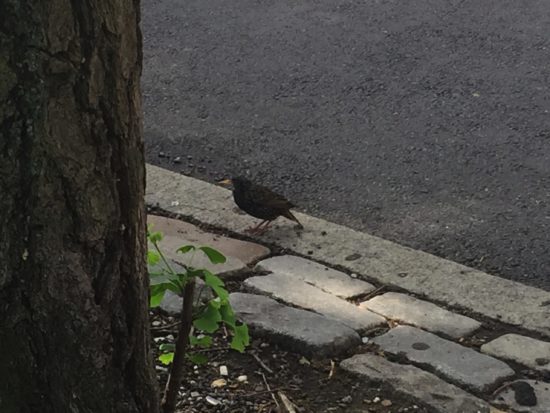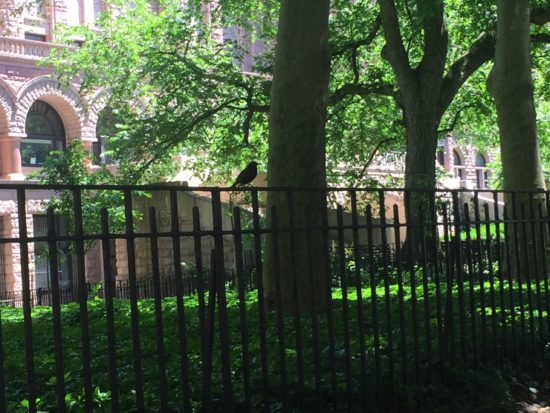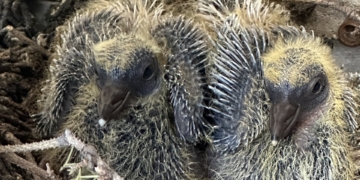
By Julia Zichello
This summer, I was away from the city for a while. I am back. And very happy to return to a place where I can walk, on sidewalks, together with other people who also walk. Here, in this magical upside-down place, even birds that can fly—choose to walk instead. Yes, I know, birds in flight are gorgeous miracles to behold, sailing into the distance like poems with plumage, but sometimes a bird just needs to be down on the street walking, and that’s cool too (except that some days, it’s hot).
One city bird in particular is an avid Upper West Side walker, often on sidewalks, or in gutters, prancing around picking up our food waste in a kind of disgusting ecosystem elegance. The European starling is an invasive bird species. It was introduced to the U.S. in 1890 and 1891, which you can read more about here (spoiler: it probably had nothing to do with Shakespeare). Today, from those early introductions there are an estimated 93 million starlings across North America (an almost 50% decrease in population size since 1970, actually). And it all started on the Upper West Side.
Starlings were first released in Central Park, near the American Museum of Natural History. And today, some 132 years later, the descendants of those early introduced individuals still nest in the eaves of the Museum. You can also find them nesting in tree holes in the parks around the museum grounds. And if you sit across from the dog park there, starlings will probably be all around you, in the grass, perching on the black metal fence, or on the back of your bench.
But well before humans or cities — a feathered, bird-like animal didn’t fly, but walked, the Earth. Feathers evolved before flight. And species like Anchiornis huxleyi, which lived around 160 million years ago, had feathers, could soar for short distances, but not fly. Bird flight evolved in stages over time, with skeletal elements such as the sternum and the shoulder changing over millions of years to eventually support flight as we know it.
After that, flightlessness evolved (several times independently) in some bird groups, mostly on islands, likely due to a combination of lack of predators and the fact that flying is energetically costly. Today, there are no truly flightless wild birds in North America, like ostriches, emus, kiwis, or penguins. But despite hundreds of millions of years of spectacular evolutionary and anatomical innovation, we now have a flying bird that throws it all away for a stroll on Columbus Avenue.
Of course, other birds walk too, like Canada Geese, Mallards, Egrets or Gulls—but not usually on Upper West Side streets for long stretches. It takes a special kind of bird for that. In fact, research shows that starlings carefully weigh the costs and benefits of foraging on the ground to maximize energy expenditure and evaluate predation risk. In ecological terms, this concept is called “optimal foraging theory.” And with bagels, prosciutto, and yellow rice sometimes strewn all over our streets, can you blame them for walking among us?
On our streets, the invasive avian trio of starlings, pigeons, and house sparrows is a familiar sight. House sparrows are the most numerous bird in the world, with 1.6 billion individuals living on every continent except Antarctica. European starlings are second only to house sparrows, with a global population of 1.3 billion. But house sparrows don’t really walk. They opt for the more adorable hop, instead. Pigeons of course do walk, even with their shorter-than-starling legs. A brilliant book called, “A Pocket Guide to Pigeon Watching,” by Rosemary Mosco, describes how pigeons don’t really bob their heads back and forth, but rather only, forth—and then their body moves forward to catch up with their head.
Walking on two legs evolved around six to seven million years ago in human ancestors. And even through all those geological epochs, studies show that walking is still beneficial for our modern brains, hearts, and overall sense of well-being. Humans are also highly social animals, so cities — for all their hardships and ugliness are undoubtedly healthy in certain ways.
To be able to walk, with other people around, is a deeply rooted soothe for the soul. These days, with crime, rats, and empty stores, maybe an inner voice says, “What am I doing here?” But what if the answer is right under the dried circles of old gum on the sidewalk, under our feet? I can’t imagine choosing to walk if I could fly, but the starling reminds us that our city gives a reason one might. Because on a fundamental level, this place is about the too many people, and the foods that we eat, all smooshed together into the built infrastructure trying to make it work. And from a starling’s perspective, this is something to come down from the sky for. Smart bird.
Julia Zichello is an evolutionary biologist who has been studying European starlings for several years.











Informative and beautifully written
Thanks! Informative and poetic. How about a closeup of one of our sparkly starlings?
Fascinating and wittily written…
Delightful article. I enjoyed learning a little bit about evolution blended with city living. This professor must have gotten As on all of his creative writing assignments in undergraduate school. Charming.
“… And even through all those geological epochs, studies show that walking is still beneficial for our modern brains, hearts, and overall sense of well-being.”
Well of course it’s beneficial to walk; the primary reason we walk is that our food is not coming to us, we have to go out & hustle to get that food to eat.
Another reason we walk (or better still, do T’ai Chi) is for our disease fighting immune system (the lymphatic system) The lymphatic system is a network of tubes, fluids (lymph) and ducts containing disease fighters like lymphocytes & macrophages.
But unlike the cardiovascular system, there’s no pump that moves these fluids along. One ingenious low energetic-cost mechanism that’s evolved that moves lymphatic fluids is muscular contractions; bodily movement, exercise. That’s one more reason sitting for long periods is bad for you; disease fighters don’t circulate as well if you sit quiescently on a couch, just like a potato might, if a potato were to watch TV… and maybe that’s why potatoes have already developed eyes, yes?
There’s a lot of lymph stored in lymph nodes and there’s a lot of lymph nodes located in the inguinal and the pelvic areas, which is why any exercise that continually and gently opens and closes the kua (Chinese term for that area) is so effective in massaging the lymph nodes and gently moving the lymph… so whether you’re moving about in search of food, or doing a lovely and meditative round of t’ai chi, you’re also simultaneously strengthening your immune system.
I could write that you’re killing two birds with the same stone here, but I won’t.
To sum up, I think the lesson is to stay away from television -this from a former TV TD, still trying to make amends for those wasted decades spent in the cold & dark of numerous TV control rooms.
Loved this!
A truly lovely story…..
Beautifully written article. Just wish the rockstars of the piece – the starlings – had their own closeup photos to show them in all their mischievous glory.
Such an enjoyable article. Thank you!
Flight is energetically cheaper than walking only on longer trips. The starting and stopping are very expensive in terms of energy. So are the muscles involved in flight even when not used for flight. On small islands with no predators and no place very far away flight makes little sense so flightlessness would be expected.
Given the spate of flight cancellations and delays, the Starling has learned that sometimes walking is faster than flying. Indeed a very “smart,” bird!
Great story! I recently was given a small featherless bird to raise if possible that was found on a hot sidewalk. I was successful and he has grown into a beautiful European Starling. I knew nothing of them until recently. They are truly a fascinating bird. Our sweet Petrie will be a forever pet due to the fact that it took him forever to want to eat on his own and now he is dependent on me. He is quite spoiled and keeps us very entertained.
I love European starlings
Lovely piece, thank you.
Two fun facts:
Starlings have different colors for each season, all very interesting, some quite striking. and Mozart had a pet starling.